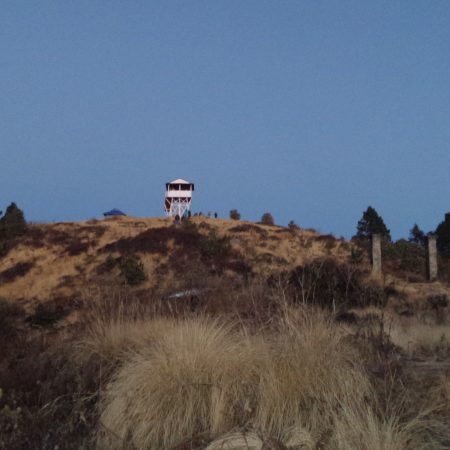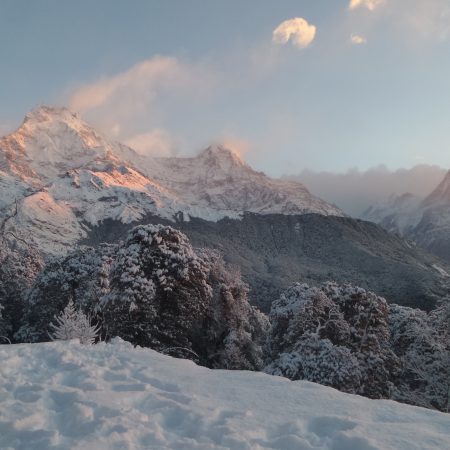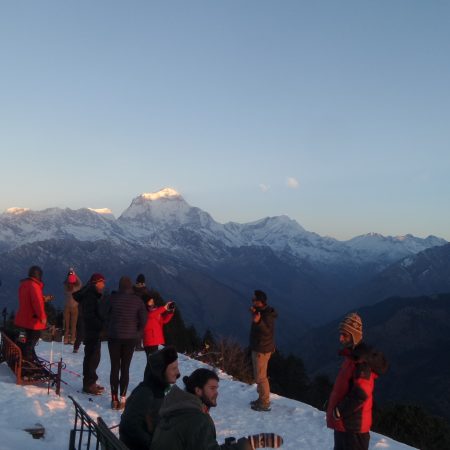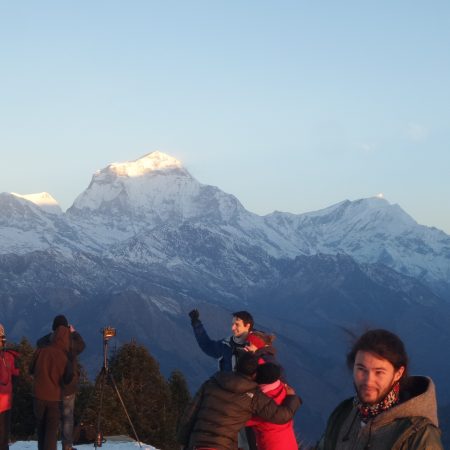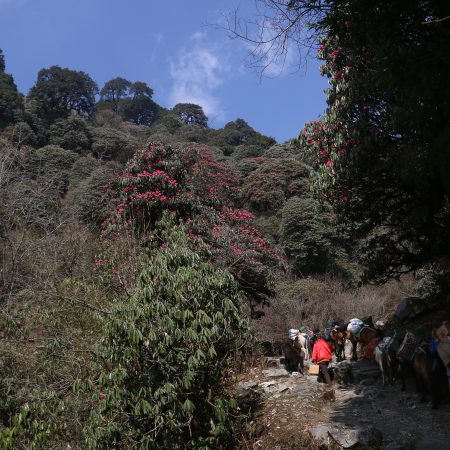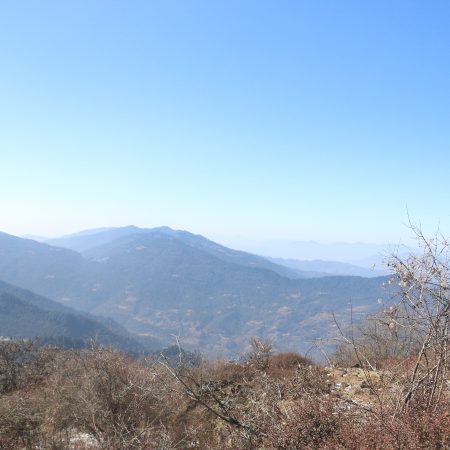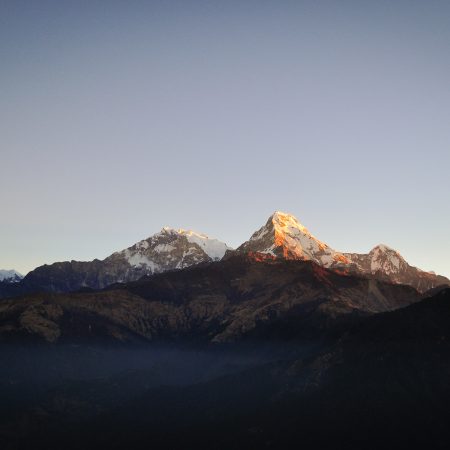5 days
3200 m
6 days
Pokhara/Pokhara
Trip Overview
Ghorepani Poon Hill Trek, also popularly known as Annapurna Sunrise Trekking or Annapurna Panorama Trekking, is a short and relatively easy trek into the Annapurna region. This trek is suitable for those who do not have much time to spend but have a burning desire to observe the beauty of snow-capped mountains. This trek allows you to be within spectacular mountain views visiting scenic hills covered within enchanting woodland of tall pines and rhododendron trees (national flower of Nepal) while providing you the opportunities to get close to the local culture. However, Poon Hill Trek is obviously best known for the sunrise views over the stunning snow-capped mountains from Poon Hill. It is a Photographer’s Paradise where you can capture some provocative glimpse of Annapurna and Dhaulagiri ranges surrounding you that can mesmerize anyone who’s the part of this awesome trek.
The Ghorepani Poon Hill trek is perhaps the ultimate short trek in the Himalayas. The trails pass through cultivated terraced fields, delightful villages inhabited by Gurungs and Magars with the spectacular views of mountain ranges ahead. The trail passes through dense rhododendron forests full of birds which makes the trek more fascinating and exciting. Hiking up to Poon Hill to watch the sunrise over the stunning snow-covered mountains is something to be treasured. Even for experienced trekkers, this is a great introduction to the Himalayas, especially if time is short. And of course, the mountains never disappoint either in their fully photogenic beauty.
Trip Itinerary
Early morning drive to Naya Pul. Meet the trailhead and proceed down the hill from the road and follow a river to Birethanti (1025m). Walk gently uphill for a couple of hours to Hille (1475m). During the hike, we pass many local villages, teahouses, gentle green rolling hills, rivers and local people. After we pass a suspension bridge in Tikedhunga, walk up to stone staircase for about 40 mins to our overnight stop at Ulleri (1960m).
A long uphill walk to Ghorepani (2750m). We walk up and down hills following the river for half an hour. Then, the stone stairs that seems to go on endlessly, passing by many homes and tea houses as it climbs. Part way up, you'll get the first view of Annapurna South. Higher up, enter a wooded area passing pink blooming trees and large bamboo plants. You'll come across a stream and past this, you'll be in Banthanti. Beyond Banthanti (2300m), enter a jungle with thick vegetation and mossy trees. Then, follow a stream up a narrow valley with more stairs to climb and emerge from the jungle at Nangathanti (2520m). From here on, another hour of climb will get you to Ghorepani.
Pre-dawn hike up to Poon Hill just in time for the view of the Dhaulagiri & Annapurna Range as it flaunts itself garbed by hues of the rising sun. Return back to your teahouse to collect your load and hit the trail to Tadapani. The trail from here wends its way east along the ridge line with magnificent views of the Annapurna. Our trail descends through rhododendron forests and waterfalls before we reach Tadapani.
Today the trekking trail descends steeply through rhododendron forests to Bhaisi Kharka. The right-hand trail makes a short, steep descent among rocks to a stream crossing then leads out a ridge towards Ghandruk. Ghandruk is the second largest Gurung village in Nepal. You can explore the maze-like streets of this thriving Gurung settlement. Enjoying a good mountain view of Annapurna South and Fishtail. Rest of the day can be spent wandering around the village, visiting the local museum and the ACAP office.
Leaving Ghandruk, a steep descent on steps marks off the day for you. As soon as you cross the stream, find yourself at a trail junction. Stay on the left-hand trail and the descent down the steps resumes. Cross another stream and make a short descent to the village of Chane. Another long stretch of downhill path will get you to Syauli Bazaar and then on to Birethanti from where the roadhead is at a short distance away.
Important Information
Include:
- Arrival/Departure
- All Private transport
- Guide for all tour/Trek
- All meals in trekking
- Porters
- Tea house Accommodation, All permits
Exclude:
- Travel Insurance
- Meals at Kathmandu & Pokhara
- Hotel at Pokhara
- Tipping
- Personal equipment
- International flight
Cost:
USD 466 per person
Single supplementary: USD 100
Trekking season in Nepal: The usual trekking season starts from September to May. During the remainder of the year, Monsoon makes travelling difficult due to wet areas and offers little in the way of mountain views. Some treks that cross high passes are better attempted in months other than December and January because of the heavy snowfall in some parts of the country. The temperature rises considerably under altitudes of 3000 ft. in April and May in some parts of the country, therefore it is wise to plan accordingly.
Teahouses in mountain: Teahouses are in the mountains where you will be staying are simple yet hospitable with good enough food and stunning views. Compare to city area teahouses are very basic but after 5-6 hours walking in the mountain you will relish the comfort. Most of these lodges have 08-to 12 room can sleep 15 to 20 people, with good food and fairly high hygiene levels. The basics of conversation and ecology are now being practiced with some success.
Guide and Porters: All guides who work with Skylark Himalayan have considerable local experience. The guide concern is his group’s welfare, health, safety and he aims to ensure you are relaxed while providing the best possible food and accommodation. And he’ll also strive to earn your friendship and will be keen for you to come to know and love Nepal.
And all the guides who work with Skylark Himalayan have guiding license from Nepal government, basic first aid training from red cross Nepal, wilderness training from SOLO outdoor school (locally known Initiative Outdoor), Child protection training and others.
Most porter come from rural areas and a farmers for 6 to 7 months of the year. These porter work hard and with care and have aims to progress into guides. Typically they live hard and frugal lives and they are used to carrying heavy loads.
Meals-Food on mountain region of Nepal
A large variety of food is found in the mountain region during trek. Even our clients say there is better food in mountain than in hotels of city. The food variations are defendant on the culture and region background but the tea-house have a menu and they do have varieties of food. Some common day meal is follow:
Breakfast
Porridge, eggs any style-usually scrambled, boiled or fried eggs, toast local bread (Gurung bread), chapatti (Indian flat bread), honey or peanut butter, organic fresh tea, coffee and many more.
Lunch
In many regions, the chief will provide a simple common hot meal in lunch. That could be potatoes, noodles, curry, salad, rice and lentil, fresh meat, vegetables and fruits. Sometimes when walking through high passes, there will be a packed lunch which may consist of common packed able lunch like bread with jam and honey, sandwich, boiled eggs, fruits, chocolates, bottle of juice. While arriving to teahouses there will be tea, coffee.
Dinner
With basic equipment they manage to make excellent cake, apple tarts, pizzas, fried potatoes, chips, spaghetti, pasta. Chefs in tea-houses are well trained in producing a variety of food and almost always ready to serve the food of specific request.
While trekking in Nepal our chefs, and assistant guide are well trained to serve and take order of the food in hygienically way. Vegetarian and vegan meals are easily catered for.
Transportation: Skylark Himalayan using a best transport company for our clients. Before departing on a trip, we using vehicle, we always check insurance of vehicle, good condition of vehicle (seatbelt, seat, wheel, looking glass, all windows etc.), Driver (driver attitude, make sure drunk or not, smartness, driving speed etc.)
Airlines: In Nepal, we have more than 10 Airlines Company but at Skylark Himalayan we only use 3 airlines which we recognize at the most reliable, safest, good companies, 1 airline company (Tara Air) for rural area like short length runway. And another 2 airlines companies (Yeti airlines & Buddha Airlines) for urban area like Pokhara, Kathmandu, Chitwan etc.
Insurance: As strongly recommended by Skylark Himalayan Travel to the clients agree to effect what they consider to be adequate Travel Insurance to cover their person and their personal effects for duration of the tours, Trekking, Rafting or any of activities in Nepal
Health and Safety: Fundamentally we have experienced staffs that have been trained in how to look after clients safely, and what to do in the event of an emergency. Almost all the company’s staffs are experienced, all leaders have done advanced first-aid training from Initiative Outdoor school, Nepal (authorized by SOLO WILDERNESS MEDICINE SCHOOL), Child Protection training, and they are well aware of the high standards that we want in maintain. We also have strong relationships with local communities, health care facilities
Responsible Travel: Skylark Himalayan completely follow tall rules, regulation and code of Nepal responsible trek organizer of responsible tourism. Responsible tourism is an action based on a sustainable idea. We work under eco-friendly environment and we want you to follow and help to save the environment. Skylark Himalayan are keen to preserve and protect the historical places and mountain to show the value of those things to coming generation.
Skylark Himalayan Travel are always aware to operate tours, trekking and other activities in eco- touristic destination to preserve natural and cultural heritages. Skylark Himalayan always aim to make extensive use of the local available products to help local communities. Skylark Himalayan staffs and guides are also employed from local communities, which helps more authentic experience for travellers. We believe that all the staffs including guide, porter, Sherpa are the back bone of organization so its our responsibility to make them happy by providing protections insurance, good salary and outdoor gear. So that, they are happy to serve good service. Without them organization can't serve the costumer need.
Customizing a Trip: The itineraries of all the trips on our website have been organized and put together by us however it does not mean you have to follow the program. If you have your own itinerary or you want to add or decrease number of days or place, we are more than happy to design your own unique itinerary with your entire favorite elements. Choice is yours with the flexibility of our tailor made itineraries.
For the more advice, please contact us via e-mail or telephonically – contact details below.
Skylark Himalayan Travel & Treks
Lakeside-6-Pokhara, Nepal
Contact no: 061-464946
Mobile: +977-9856010460 / 9801050460
Whatapps: +9779801050460
Skype: tara.gautam2
E-mail: sales@skylarkhimalayantravel.com
skylarkhimalayan@gmail.com
Visa Information: Nepal Government makes things easy for foreign travellers. The easiest way to get a tourist visa in Nepal is by applying on arrival in Kathmandu at international airport (TIA) or at any of the land border crossing open to foreigners (each has immigration offices). But you can also apply in advance at one of Nepal's foreign consulates from abroad.
There are three options for the length of a tourist visa (for south Asian country, the first 30 days is free. The cost of visa is depending upon the days you stay. The multiple-entry visa valid for 15, 30 and 90 days costs $25, 40 and 100 USD. It is good idea to keep a number of passport photos with your passport. Indian passport holder doesn’t need a visa to enter Nepal.
Visa Extensions
You can extend your visa from immigration office in only Kathmandu and Pokhara up to 150 days per calendar year. It will cost $30 USD for 15 days and $2 USD per day after 15 days. Visa extension required your passport, the fees, one passport sized photo and an application form to complete the process.
And for more information about visa please click below link: https://www.welcomenepal.com/plan-your-trip/visa-nepal-information.html
Feedback Please: If you have any complains to report, comments or any question about the trip (food, tea-house, guide, porter, management of office or anything) you took with Skylark Himalayan, please send us your feedback because we would like to solve problems that arise uplift our company. If you don't have a specific question, we’re always eager to hear what visitors think of this company.
High Altitude Sickness:
1) What is altitude sickness?
- Altitude sickness is a negative health effect of high altitude on ones health, caused by acute exposure to low amounts of oxygen at high altitude.
- The exact cause of AMS is not exactly known. It is thought to be a response of the brain to the lower oxygen levels in the blood at higher altitudes. This produces some swelling of the brain.
2) Acute mountain sickness (AMS)
- AMS is also called altitude sickness.
Acute mountain sickness (AMS) is the effect on the body of being in a high altitude environment. Especially while people are trekking around the Himalayas they face problem related to moving in high altitude areas. AMS is common at high altitudes, that is above 8,000 feet (2,440 meters). Three-quarters of people have mild symptoms of AMS over 10,000 feet (3,048 meters). The occurrence of AMS depends on the altitude, the rate of ascent, and individual susceptibility and activeness.
3) Acute mountain sickness common symptoms?
Symptoms usually start 12-24 hours after arrival at altitude and include
- Headache (not relieved by medication)
- Dizziness
- Fatigue
- Decreased coordination (Normal activity is difficult.)
- Shortness of breath,
- Loss of appetite
- Nausea
- Disturbed sleep
- General feeling of malaise.
- Inability to walk
- Decreasing mental status
- Fluid build-up in the lungs
- Vomiting
- Loss of energy
- Difficulty in urination
#These symptoms tend to be worse at night when respiratory drive is decreased.
4) Prevention of AMS?
- Take special care if you have previously had acute mountain sickness (AMS).
- If symptoms of AMS develop, delay further ascent.
- If symptoms become worse, move down (descend) as soon as possible.
5) Treatment of AMS?
- The most important treatment if you start to develop symptoms of mild AMS is to stop your ascent and to rest at the same altitude
- For most people, symptoms will improve within 24-48 hours with no specific treatment.
- Simple painkillers such as ibuprofen or paracetamol will help the headache.
- Anti-sickness medication may also be used. (Acetazolamide)
- Treatment with oxygen and the medicine nifedipine may also help symptoms but does not replace the need for descent.
Note- all the trekking leaders and guide from skylark Himalayan are well trained about altitude sickness, AMS and other related sickness in mountain. You should mention, if you previously have any health problem.
TREKKING SUGGESTED EQUIPMENT
(Up to 5,500 m.)
- 1 Pair strong mountain / hiking boots (well worn-in and with ankle support)
- 1 Small daypack
- 1 Sleeping bag (comfortable to -10C)
- 1 Down jacket / all weather Anorak
- 1 Light water & windproof jacket
- 2 - 1-litre water bottles
- 1 Inner sleeping sheet (?)
- 1 Torch / flashlight & spare batteries
- 1 Medium sized travel towel (quick drying)
- 1 Washing kit: include Personal toiletries
- Talcum powder, Blister plasters, Toilet paper
- Bio degradable soap / shampoo
- Anti-bacterial gel for 'washing' hands
- First-Aid kit (please make sure it is trek and wilderness specific) and any personal medication
- 1 Pair sport shoes/sandals (for the time off the trek)
- 2 Pairs lightweight trousers
- 2 Pair shorts
- 1 Fleece / warm sweater
- 1 Sweatshirt / light sweater
- 2 T-Shirts
- 2 Long sleeve cotton (or polypropylene) shirts
- 3 Pairs heavy wool socks
- 2 Pairs light socks
- Walking poles
- Underwear (including thermals)
- Cotton Headscarf / bandanna
- Sunglasses (with side shields and UV protective lenses) and sunhat
- Sunscreen Lotion (30-50 SPF), Money belt (?)
- Warm hat and gloves (preferably waterproof)
- 3 to 4 Plastic bags (for wrapping clothes)
- Water purification tablets/ solutions (preferably iodine)
- Insect repellant
- Adapter plug (for charging camera batteries and other electronic devices)


